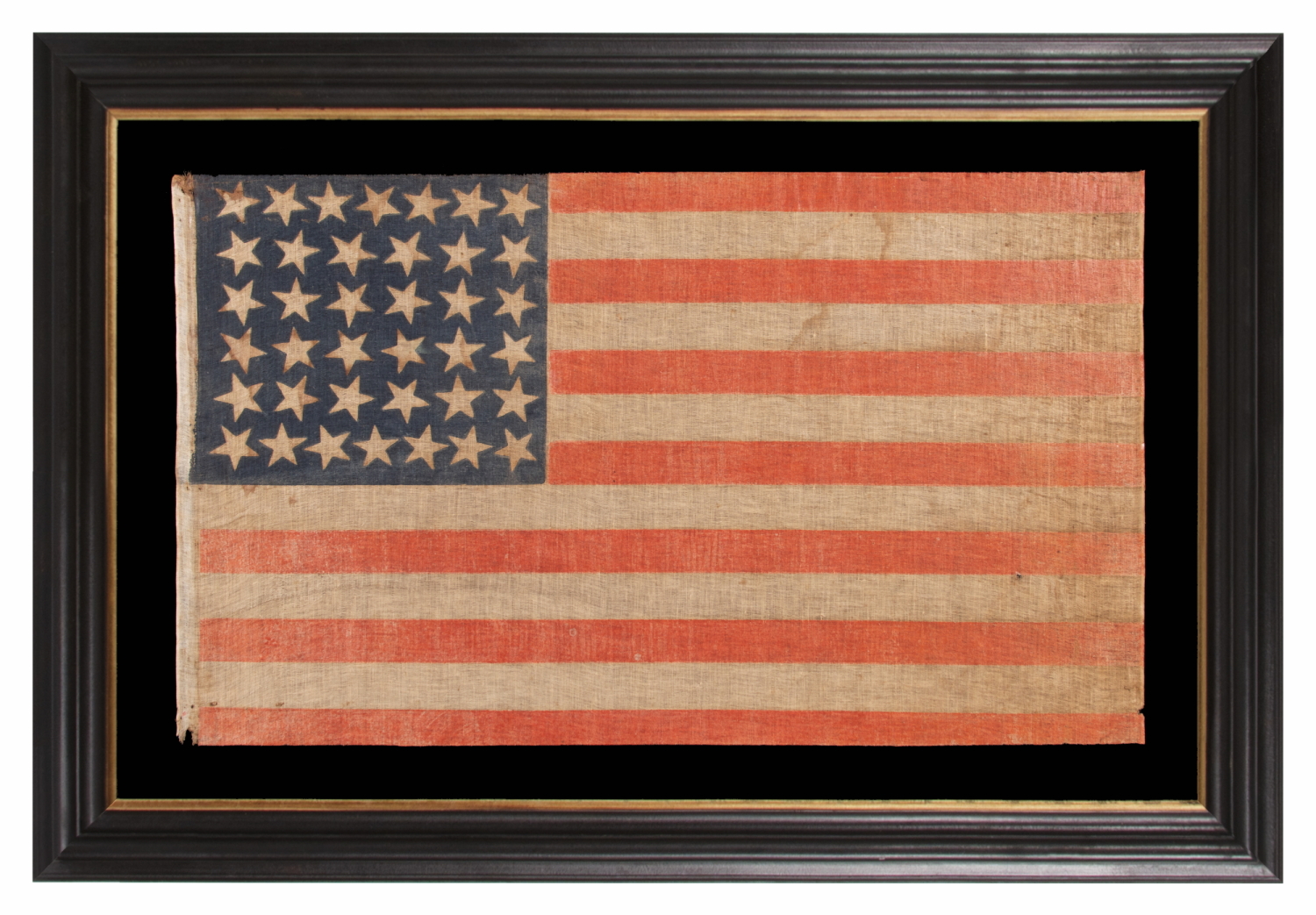


| 38 STAR ANTIQUE AMERICAN PARADE FLAG WITH JUSTIFIED ROWS OF 7-6-6-6-6-7 AND SCATTERED STAR ORIENTATION, MADE DURING THE PERIOD WHEN COLORADO WAS THE MOST RECENT STATE TO JOIN THE UNION, 1876-1889 |
|
| Web ID: | 38j-1146 |
| Available: | In Stock |
| Frame Size (H x L): | Approx. 33.5" x 49" |
| Flag Size (H x L): | 21.5" x 37" |
| Description: | |
| 38 star American national parade flag, printed on coarse cotton, possibly with flax content. One of the flag’s most interesting features is the wild sweep of the grain of the fabric, the warp and weft of which are anything but perpendicular. The stars are arranged in justified rows of 7-6-6-6-6-7. This results in a secondary pattern that I commonly call a “box-in-a-box-in-a-box”, because of the way in which the seemingly haphazard arrangement creates three consecutive squares. Note how the stars point in various directions on their vertical axis, which adds a nice element of folk quality to the overall design. Most parade flags in this star count have red stripes that lean heavily toward orange, with a vibrant, chromatic luster. This was common across printed flags produced between the 1850's and the 38 star period, phasing out in the last decade of the 19th century. Also note how the wear and patina contribute to an endearing presentation that displays its long-term use gracefully. Colorado became the 38th state on August 1st, 1876. This was the year of our nation’s 100-year anniversary of independence. Per the Third Flag Act of 1818, stars were not officially added until the 4th of July following a state's addition. For this reason, 37 was the official star count for the American flag in 1876. In the latter 19th century, it became common to add stars before the respective state(s) had even entered the Union. No one cared what was official, not even the military, where the matter of practicality with regard to flags always seems to have outweighed regulations. In the private sector, commercial flag-making was a competitive venture. Few flag-makers continued to produce 37 star flags when their competitors had jumped the star count to 38. It is for this reason that 38 and 13 stars (to represent the original 13 colonies) are more often seen at the Centennial International Exposition, the six-month long World’s Fair, held in Philadelphia, that served as the nucleus of the national celebration. Some makers of printed parade flags actually began to produce 39 star flags in 1876, in hopeful anticipation of the addition of two more Western Territories instead of one. The 39th state would not join the Union for another 13 years, however, when the Dakota Territory—thought to be coming as a single state—entered as two separate states on November 2nd, 1889. The 38 star flag generally fell out of production at that time, though it technically remained official until July 3rd, 1890. President Ulysses S. Grant was in office when the first 38 star flags would have appeared. The list of presidents that served during the period when the 38 star flag was official include Rutherford B. Hayes, James Garfield, Chester Arthur, Grover Cleveland, and Benjamin Harrison. Mounting: The flag was mounted and framed within our own conservation department, which is led by expert trained staff. We take great care in the mounting and preservation of flags and have framed thousands of examples. Feel free to contact us for more details. The background is 100% cotton twill, black in color, that has been washed and treated for colorfastness. The black-painted molding, with a wide, sculpted form and a gilded inner edge, is Italian. The glazing is U.V. protective Plexiglas. Condition: There is moderate loss of red-orange pigment at the hoist and fly ends, and minor to modest elsewhere. There is minor to moderate of the same in the canton. There is modest golden brown oxidation in the striped field and along the hoist, with some water staining. There is minor to moderate of the same in the stars, with more significant staining in the extreme, upper, hoist-end corner, extending into the white area of the hoist. There is minor fraying and fabric loss at the top and bottom of the hoist area, accompanied by tack holes where the flag was once affixed to a split wooden staff. There is a tiny hole near the end of the 5th white stripe and a tiny nick at the end of the last white stripe. Many of my clients prefer early flags to show their age and history of use. |
|
| Video: | |
| Collector Level: | Intermediate-Level Collectors and Special Gifts |
| Flag Type: | Parade flag |
| Star Count: | 38 |
| Earliest Date of Origin: | 1876 |
| Latest Date of Origin: | 1889 |
| State/Affiliation: | Colorado |
| War Association: | 1866-1890 Indian Wars |
| Price: | Please call (717) 676-0545 or (717) 502-1281 |
| E-mail: | info@jeffbridgman.com |
 |
|